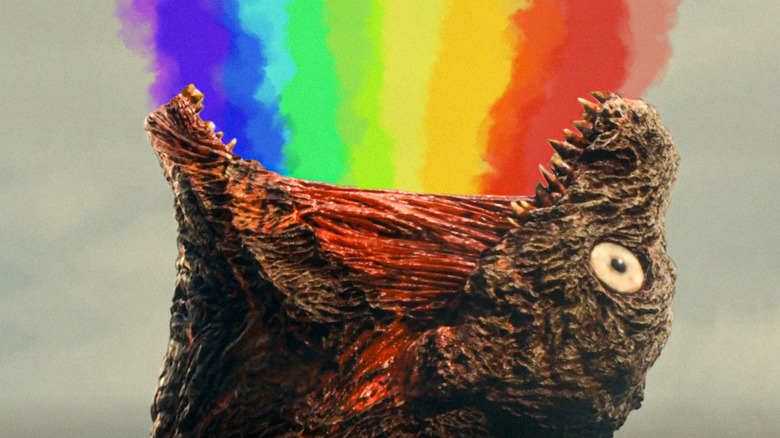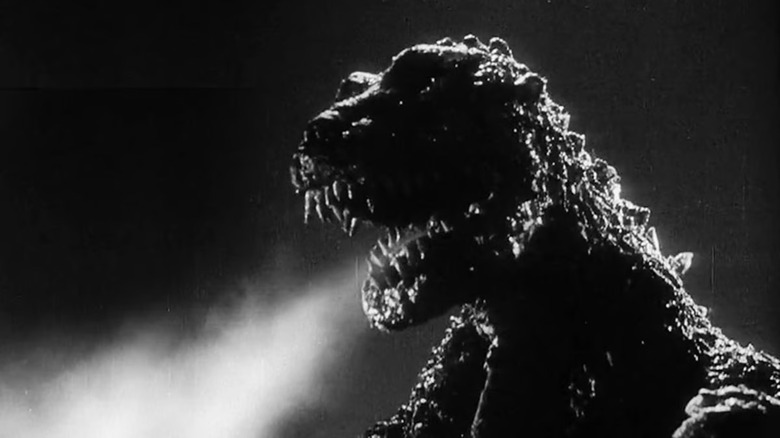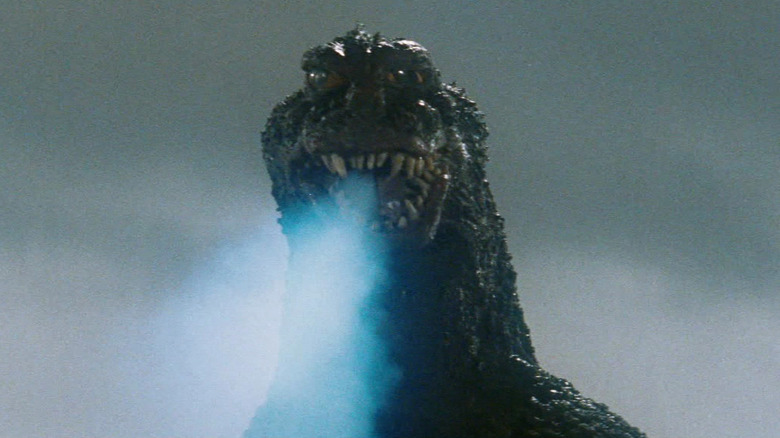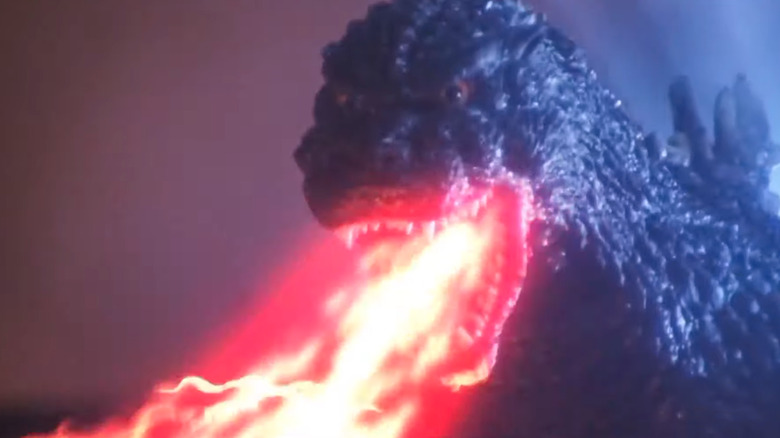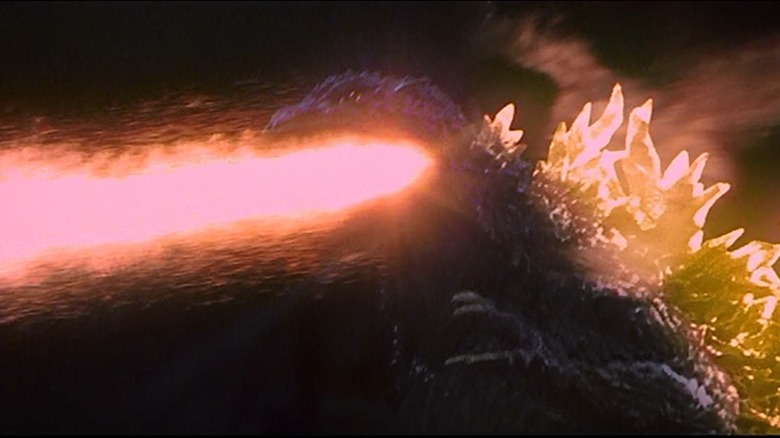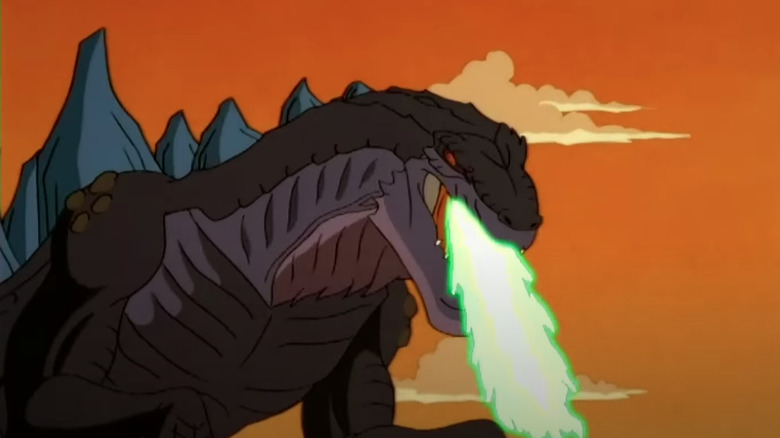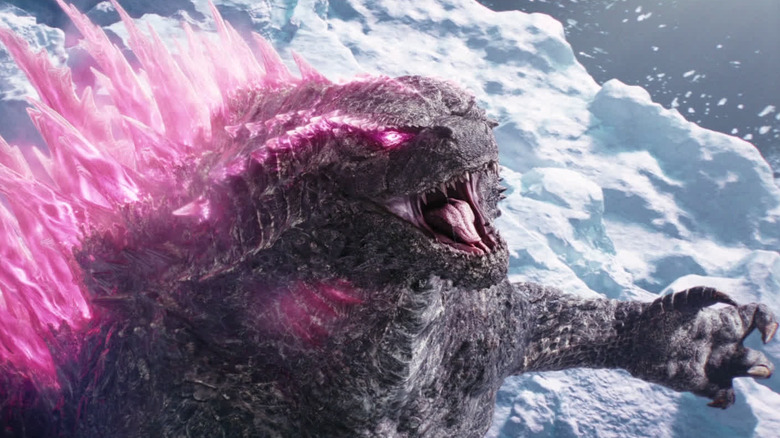Godzilla's Different Atomic Breath Colors And Their Meanings Explained
The first trailer for upcoming MonsterVerse movie "Godzilla x Kong: The New Empire" featured a baby Kong and a new giant ape villain called Skar King, but both were overshadowed by the star of the show: Pink Godzilla.
Though Godzilla is most commonly associated with his classic white-blue atomic breath, director Adam Wingard isn't the first filmmaker to experiment with the color spectrum when it comes to Godzilla's most lethal power. There have been a dozen different continuities featuring the giant lizard, who has been reinvented and redesigned both drastically and subtly over the years.
The pink-glowing version of Godzilla is the same one that was featured in Warner Bros. Pictures and Legendary Pictures' "MonsterVerse" movies — starting with "Godzilla" in 2014 and most recently appearing in the spin-off series "Monarch: Legacy of Monsters." But even within the decade-long lifespan of the MonsterVerse, we've also seen other versions of the big lizard boy in Toho's "Shin Godzilla" and "Godzilla Minus One," an anime trilogy from Toho Animation that released on Netflix, and the animated series "Godzilla Singular Point," also released on Netflix. In these releases and many others before them, Godzilla's atomic breath has taken on a variety of colors with some truly devastating effects.
Godzilla's original white atomic breath
70 years ago, when Godzilla first made his appearance on the big screen, the color options for atomic breath were limited to monochrome. Credit for the creation of Godzilla is generally divided across three men: producer Tomoyuki Tanaka, who was inspired to invent Japan's own atomic monster after seeing the Rhedosaurus in "The Beast from 20,000 Fathoms"; director Ishirō Honda, who brought his experience directing special effects-heavy war films, and also co-wrote the screenplay; and special effects master Eiji Tsuburaya, who built the human-operated monster suit and smaller puppets that made Godzilla come to life.
The atomic breath effect was achieved using one of the puppets, which had a nozzle in its mouth that sprayed a concentrated stream of fine mist. This appeared white on screen, conveying an impression of white-hot energy that has been a core element of the power ever since. It was enhanced by the old-school equivalent of CGI: painstakingly drawing effects onto the film reel frame-by-frame to create the lighting-up of Godzilla's dorsal plates that accompany the blast. The results are impressive, and "Godzilla" became a landmark in the history of special effects. And yet, with how subsequent films have ramped up Godzilla's power levels, the original atomic breath now seems underpowered compared to more modern incarnations.
In the 1954 film, scientists observe that footprints left behind by Godzilla are highly radioactive, and conclude that the creature "must have absorbed an enormous amount of atomic radiation" from nuclear weapon testing. This explains the source of the atomic breath and also raises a frightening question: if absorbing such massive amounts of radiation didn't kill Godzilla, then what can kill it?
Godzilla goes blue
Godzilla's third film, and the second directed by Honda, marked his first appearance in color, and therefore the first appearance of the blue tinge to his atomic breath. "King Kong vs. Godzilla" (1962) struck a much sillier tone than the 1954 film, particularly when the two titular monsters go head-to-head in a battle that was designed to evoke the drama and pageantry of pro-wrestling.
In dialogue, the blue light of Godzilla's breath is compared to Cherenkov radiation, the same glow that's seen around underwater nuclear reactors and has even been observed by patients undergoing radiation therapy, due to the radiation particles passing through the fluid inside their eyeballs. It's caused by particles moving faster than the speed of light, which is possible due to light moving through water about 25% slower than it does through air. Perhaps, true to the mist-spraying nozzle used on set to create the effect, Godzilla's atomic breath is actually water vapor charged with radioactive particles. That certainly fits with the creature's origin story as something that emerged from beneath the ocean.
Shin Godzilla and the purple atomic death laser of doom
There is another explanation for the color tinges of Godzilla's atomic breath, and this one better explains the variety in color that we've seen: ionized air. Seen surrounding mushroom clouds in the aftermath of nuclear explosions, this also tends to have a blueish tinge, but with a greater range that includes purples and violets. Purple atomic breath was most memorably (and terrifyingly) deployed in "Shin Godzilla," a 2016 Toho reboot of the franchise that retooled the creature's origin story and reimagined its biology.
In this iteration, Godzilla doesn't start out as the upright-standing lizard, but in a form that crawls out of the ocean on stubby limbs. Due to its contact with nuclear waste dumped on the ocean floor, Shin Godzilla's body evolves rapidly, painfully, and grotesquely. It rises to become bipedal, but its arms remain underdeveloped and mostly useless. It has bulging eyes and skin that looks red, raw, and cracked. Its jaw unhinges like a snake, and eventually, the lower jaw splits in half as well. And when those jaws open, a city falls.
A far cry from the white mist that causes a car to catch fire after a few seconds of concentrated spraying in the original "Godzilla," Shin Godzilla's atomic breath resembles a laser: a highly concentrated beam with a purple-violet tinge that slices through high-rise buildings for miles around like a giant cheese wire made of pure energy. Not only is its range enormous and its destructive power unstoppable but this version of the atomic breath isn't confined to Shin Godzilla's mouth. It also bursts out of the end of the creature's tail and from the dorsal plates themselves, creating a dazzling light show effect — the last light show you'll ever see.
Godzilla's hot red spiral ray
Back in the 1990s, Godzilla began to feel the heat and his atomic breath was infused with a fiery aspect: the spiral heat ray. Typically deployed in final battles after absorbing energy from elsewhere — like Rodan's fire energy in "Godzilla vs. Mechagodzilla II" or from cosmic energy in "Godzilla vs. SpaceGodzilla" — the spiral heat ray is a power-up that gives Godzilla the edge he needs to defeat his most powerful enemies. It's visually distinct from his traditional blue atomic ray not only because of its color, but by the presence of spiraling lines of energy surrounding the central beam.
Power-ups come at a price, though. In 1995's "Godzilla vs. Destoroyah," the creature resurfaced in a new form that's become known as Burning Godzilla, with raging, painful-looking patches of fiery skin. The condition is caused by Godzilla's body containing unstable levels of radiation — so unstable, in fact, that he is at risk of exploding and taking the Earth with him. In the climactic battle with Destoroyah, Burning Godzilla unleashes an even more juiced-up version of the spiral heat ray. These efforts cost Godzilla his life, but as a final act of love, he uses his radioactive energy to revive his son, LittleGodzilla, who emerges from the ashes no longer little but looking exactly as tall and terrifying as his dad.
Godzilla's burning form was more recently featured in the final battle of "Godzilla: King of the Monsters" when he got a much-needed power-up from his sweet friend Mothra (RIP). Rather than firing the spiral heat ray, though, the MonsterVerse's Godzilla unleashed a series of massive nuclear pulses from his entire body that killed Ghidorah, while fortunately also stabilizing Godzilla and avoiding a potential Earth-wrecking meltdown.
Godzilla 2000's alien-melting orange blast
There's no better time to experiment with your color palette than the start of a new millennium. The Godzilla of "Godzilla 2000: Millennium" embraced the rainbow with greenish skin and purple dorsal plates creating a Joker-esque aesthetic. But Godzilla doesn't joke around when it comes to unleashing his atomic breath, which in this movie is a fiery orange — similar to the spiral heat ray, but without the spirals, and without a need for a power-up beforehand.
The plot of "Godzilla 2000" centers around the reemergence of an alien species called the Millennians, who crash-landed on Earth millions of years ago and laid dormant until the lights of a submarine disturbed their slumber. The Millennians attempt to conquer Earth by absorbing Godzilla's DNA, but like humans before them, they realize too late that they've bitten off more than they can chew. The atomic power transforms the Millennians into a grotesque kaiju called Orga, which then attempts to literally bite off more than it can chew by eating Godzilla. Once inside Orga's gullet, Godzilla lets rip with a fiery orange atomic blast that incinerates the monster from within and takes out a good chunk of the surrounding city.
Godzilla also breathed fire in the 1978 animated series by Hanna-Barbera (and, of course, in "Animaniacs"), but '90s kids may have vague memories of a cartoon Godzilla with green atomic breath. If you do, you're not imagining things.
Zilla Jr.'s green power breath
The 1998 American "Godzilla" movie was not well-received by critics and is not fondly remembered by Godzilla purists. The radically altered design, with its iguana-like jaw and total lack of atomic breath setting it apart from the weak-chinned but strong-breathed Toho Godzilla, was later dubbed "Zilla" by Toho in order to distinguish it from the true Godzilla.
Sony had big ambitions for Godzilla, though, and had already sold 40 episodes of a spin-off cartoon series to Fox Kids several months before the movie's release. "Godzilla: The Series" storyboard artist Tim Eldred recalls that the revamped look for Godzilla was kept a closely guarded secret even from the people who were supposed to be drawing it. This problem was finally solved a few days before the movie's premiere. The team was out to lunch in a mall when they spotted a toy store employee mistakenly putting tie-in Zilla toys on the shelves slightly too early. A director for the cartoon show bought one of the toys, finally giving the artists their first decent drawing reference.
The main Godzilla in the series is actually the son of the Godzilla from the 1998 movie, who imprints on biologist Nick Tatopoulos (played by Matthew Broderick in the movie, and voiced by Ian Ziering in the show) and works with a team of humans to subdue unruly monsters around the world. It only ran for two seasons, but "Godzilla: The Series" is generally remembered much more fondly by fans than the movie it was connected to. Though Zilla Jr. closely resembles his parent in appearance, he's much more durable and — crucially — battles his enemies with green atomic breath.
It might be a non-traditional color, but it gave Godzilla back the long-range weapon that he'd lacked in the movie, and which has been such a defining element of the creature's design. Fans have even warmed to Zilla Jr.'s great big chin, earning him the affectionate nickname "Chad Godzilla."
Get ready for Pinkzilla
We've seen Godzilla go pink-ish before — not only in "Shin Godzilla," but also in the animated series "Godzilla: Singular Point" — but the pink has always been mixed in with shades of violet or blue or red. Not so in the upcoming "Godzilla x Kong: The New Empire," which sees Godzilla awakening inside an icy prison and emerging with hot pink atomic energy.
The blue atomic breath of the MonsterVerse edition of Godzilla is one of the most powerful versions we've seen. In "Godzilla vs. Kong," the big lizard used his breath to blast a hole right through the Earth's crust, opening up a shortcut to the Hollow Earth just to say "Come at me, bro!" to Kong. Nonetheless, Godzilla took a beating in the movie, particularly during the final battle with Mechagodzilla, so a period of hibernation and healing is probably just what the kaiju doctor ordered. In the first trailer for "Godzilla x Kong," Godzilla appears to be drawing some kind of energy from below the ice; he may be using some kind of Hollow Earth power source to juice himself up.
Behind the scenes, the main reason for Godzilla going pink is simply that director Adam Wingard thought it would look cool — and it might not be the only unusual color we see. "I wanted to do different things with the spines and try different colors," Wingard revealed recently, though he gave his assurances that it's not an arbitrary change: "I didn't want it to just be random; it's part of the story."
We'll find out why when "Godzilla x Kong: The New Empire" hits theaters on March 29, 2024.
